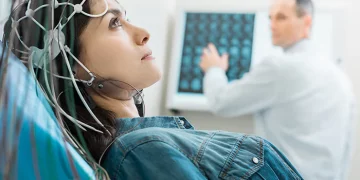Introduction: The Evolution of Acupuncture in the Digital Age
Acupuncture, a cornerstone of traditional Chinese medicine (TCM) for over 2,000 years, has long been celebrated for its ability to balance the body’s energy flow or Qi by stimulating specific meridian points. Historically performed with fine needles, acupuncture is recognized for alleviating pain, reducing stress, and promoting holistic wellness. However, as digital health technologies advance rapidly, a new wave of innovation is poised to transform this ancient practice. Digital acupuncture devices that use neuroelectric pulses to simulate meridian stimulation are emerging, leveraging algorithms and biofeedback to enhance efficacy and accessibility. This article investigates how these devices work, their scientific basis, and the implications of replacing—or supplementing—human acupuncturists with algorithm-driven tools.
The Fundamentals of Acupuncture and Meridian Theory
Traditional acupuncture is based on the concept that Qi, or vital energy, circulates along defined pathways called meridians. Blockages or imbalances in this flow manifest as physical or emotional symptoms. By inserting needles at precise acupoints, practitioners aim to restore energetic harmony, facilitating the body’s natural healing processes.
Modern research shows acupuncture’s influence on the nervous system, including stimulation of peripheral nerves, release of endorphins, and modulation of inflammation. These physiological effects partially explain acupuncture’s benefits despite the metaphysical framework being less understood in Western science.
What Are Digital Acupuncture Devices?
Digital acupuncture devices represent the convergence of traditional medicine with neurotechnology and AI. These gadgets deliver controlled neuroelectric pulses to targeted acupoints, replicating the effects of needle stimulation without skin penetration. Often wearable or handheld, they utilize electrical stimulation, sometimes called transcutaneous electrical nerve stimulation (TENS) or electroacupuncture, enhanced with algorithmic modulation for precision.
Such devices can be programmed to mimic complex acupuncture protocols, adjusting pulse frequency, intensity, and timing based on user feedback or preset therapeutic goals. Some connect with mobile apps, offering guided sessions, treatment tracking, and data analytics.
How Neuroelectric Pulses Mimic Meridian Stimulation
The principle behind neuroelectric stimulation is that electrical impulses activate nerve fibers similarly to how acupuncture needles do. By sending mild, controlled currents through the skin at acupoints, these devices trigger nervous system responses including pain gate control, endorphin release, and improved local circulation.
Algorithmic modulation allows pulses to vary dynamically, simulating the practitioner’s manual needle manipulation techniques, such as twirling or lifting. This nuanced stimulation aims to maximize therapeutic impact while minimizing discomfort.
Neuroelectric stimulation also interacts with autonomic nervous system pathways, supporting relaxation and stress reduction akin to traditional acupuncture outcomes.
Advantages of Digital Acupuncture Devices
- Non-invasive and Painless: Eliminates needle anxiety and infection risks.
- Convenience and Accessibility: Users can self-administer treatments at home without needing a trained acupuncturist.
- Customizable Protocols: Algorithms tailor stimulation patterns to individual needs or health conditions.
- Data-Driven Feedback: Real-time monitoring of physiological responses refines treatment efficacy.
- Cost-Effective Over Time: Reduced dependency on frequent clinic visits lowers healthcare expenses.
Scientific Evidence and Clinical Validation
Numerous clinical trials validate electroacupuncture’s effectiveness for pain relief, migraine reduction, and muscle recovery, often comparable to manual needling. Digital devices using neuroelectric pulses build on this foundation, with early studies indicating improvements in chronic pain, anxiety, and sleep disorders.
However, comprehensive, large-scale trials on fully automated digital acupuncture systems remain limited. Research is ongoing to optimize stimulation parameters, assess long-term benefits, and compare outcomes with traditional acupuncture delivered by skilled practitioners.
Integration of AI and Algorithms in Treatment Personalization
Artificial intelligence enhances digital acupuncture by analyzing biometric data—such as heart rate variability, skin conductance, and muscle tension—to personalize stimulation. Machine learning algorithms can detect patterns indicating treatment effectiveness or patient comfort, automatically adjusting pulse characteristics accordingly.
Such adaptability reflects the nuanced skill of a human acupuncturist, who senses patient responses and modifies technique in real time. Algorithms promise consistent precision and scalability, potentially democratizing access to effective acupuncture therapies worldwide.

Ethical and Practical Considerations
The rise of algorithm-driven acupuncture prompts questions about safety, efficacy, and the patient-practitioner relationship. While digital devices offer autonomy and convenience, overreliance on technology may diminish the holistic, relational healing aspects integral to traditional acupuncture.
Privacy is a concern as biometric data collected for personalization must be securely stored and ethically managed. Regulatory frameworks must evolve to ensure device safety, standardize protocols, and prevent misuse.
Training and certification of users become crucial to avoid improper application that could reduce benefits or cause harm.
Market Trends and Consumer Adoption
The global acupuncture devices market is growing steadily, driven by increased demand for non-pharmacological pain management and holistic wellness tools. Consumer interest in wearable health tech and telemedicine further accelerates adoption of digital acupuncture.
Innovative startups and established medical device companies are investing in research, marketing digital acupuncture as part of integrative health packages. Partnerships with health insurers and clinics aim to legitimize and broaden usage.
Target demographics include chronic pain sufferers, stressed professionals, athletes seeking recovery, and wellness enthusiasts embracing self-care technologies.
Case Studies: Digital Acupuncture in Practice
- A recent pilot program utilized wearable neuroelectric stimulators for fibromyalgia patients, reporting significant pain reduction and improved sleep quality over 12 weeks.
- Telehealth platforms incorporated digital acupuncture devices paired with remote practitioner monitoring, enabling personalized treatment adjustments and enhanced patient engagement.
- Users with needle phobia found digital devices a viable alternative, allowing them to experience acupuncture benefits without discomfort or fear.
Challenges and Limitations
Despite promising advancements, digital acupuncture cannot yet fully replicate the intuition, diagnostic skills, and energetic sensitivity of experienced acupuncturists. Complex cases requiring nuanced palpation and individualized assessment may still require traditional methods.
Technological challenges include ensuring device reliability, battery life, and user-friendly interfaces. Moreover, placebo effects and patient expectations continue to influence outcomes, complicating objective assessments.
Healthcare integration remains limited, with some clinicians skeptical or unfamiliar with digital acupuncture tools.
The Future of Acupuncture: Hybrid Models and Collaborative Care
Rather than replacing human acupuncturists, digital devices may serve as complementary tools—enhancing clinical practice through pre-treatment diagnostics, home-use support, and therapy monitoring.
Hybrid models combining in-person sessions with AI-driven home care optimize patient outcomes while respecting the art of acupuncture. Integration with other digital health platforms could enable holistic, multi-modal care addressing physical, mental, and emotional health.
Training programs may evolve to teach acupuncturists how to incorporate technology ethically and effectively, maintaining therapeutic relationships while embracing innovation.
Practical Advice for Prospective Users
- Consult healthcare professionals before using digital acupuncture devices, especially for serious or chronic conditions.
- Choose FDA-approved or medically certified devices from reputable manufacturers.
- Follow manufacturer instructions carefully to avoid misuse or injury.
- Combine digital acupuncture with lifestyle modifications such as exercise, nutrition, and mindfulness for best results.
- Monitor and report any adverse effects promptly to ensure safety.
Conclusion: Toward a Digitally Enhanced Acupuncture Era
Digital acupuncture devices powered by neuroelectric pulses and sophisticated algorithms represent a transformative evolution in holistic health. By simulating meridian stimulation with precision and adaptability, these tools democratize access to ancient healing practices in a modern context.
While challenges around validation, ethics, and user education remain, the fusion of acupuncture and AI holds immense potential to improve wellness outcomes and patient autonomy. As technology matures, the question is not if but how acupuncturists and algorithms will collaborate to shape the future of energy medicine. The next acupuncturist might very well be an algorithm—but one that works hand in hand with human expertise to promote healing in unprecedented ways.











































